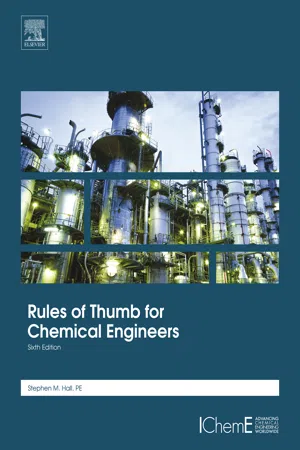
- 516 pages
- English
- ePUB (mobile friendly)
- Available on iOS & Android
Rules of Thumb for Chemical Engineers
About This Book
Rules of Thumb for Chemical Engineers, Sixth Edition, is the most complete guide for chemical and process engineers who need reliable and authoritative solutions to on-the-job problems. The text is comprehensively revised and updated with new data and formulas. The book helps solve process design problems quickly, accurately and safely, with hundreds of common sense techniques, shortcuts and calculations. Its concise sections detail the steps needed to answer critical design questions and challenges. The book discusses physical properties for proprietary materials, pharmaceutical and biopharmaceutical sector heuristics, process design, closed-loop heat transfer systems, heat exchangers, packed columns and structured packings.
This book will help you: save time you no longer have to spend on theory or derivations; improve accuracy by exploiting well tested and accepted methods culled from industry experts; and save money by reducing reliance on consultants. The book brings together solutions, information and work-arounds from engineers in the process industry.
- Includes new chapters on biotechnology and filtration
- Incorporates additional tables with typical values and new calculations
- Features supporting data for selecting and specifying heat transfer equipment
Frequently asked questions
Information
Safety
Abstract
Keywords
Introduction
Process Safety Management (PSM)
| Element | Description |
| Employee participation | Employers must consult with their employees and their representatives regarding the employer's efforts in the development and implementation of the PSM program elements and hazard assessments. Employers must also train and educate their employees and to inform affected employees of the findings from incident investigations required by the PSM program |
| Process safety information | Complete and accurate written information concerni... |
Table of contents
- Cover image
- Title page
- Table of Contents
- Copyright
- Preface
- Chapter 1: Safety
- Chapter 2: Process Evaluation
- Chapter 3: Process Modeling
- Chapter 4: Fluid Flow
- Chapter 5: Vessels
- Chapter 6: Blending and Agitation
- Chapter 7: Pumps
- Chapter 8: Fans, Blowers, and Compressors
- Chapter 9: Vacuum Systems
- Chapter 10: Pneumatic Conveying
- Chapter 11: Filtration
- Chapter 12: Heat Exchangers
- Chapter 13: Closed-Loop Heat Transfer Systems
- Chapter 14: Fractionators
- Chapter 15: Absorbers
- Chapter 16: Controls
- Chapter 17: Biopharmaceutical Systems
- Chapter 18: Bioprocessing
- Chapter 19: Energy Conservation
- Chapter 20: Drivers
- Chapter 21: Boilers
- Chapter 22: Cooling Towers
- Chapter 23: Refrigeration
- Chapter 24: Reliability
- Chapter 25: Metallurgy
- Chapter 26: Troubleshooting
- Chapter 27: Startup
- Chapter 28: Conversion Factors and Constants
- Chapter 29: Properties
- Appendix A: Resources
- Appendix B: Tank Cleaning
- Index